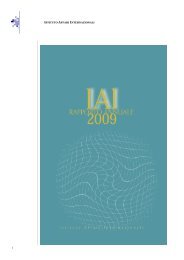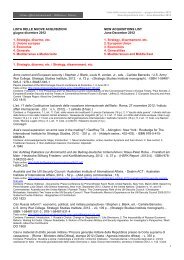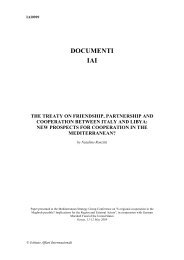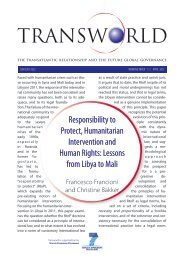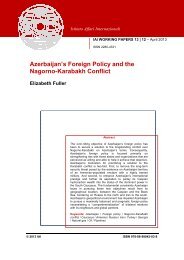La minaccia NBCR - Istituto Affari Internazionali
La minaccia NBCR - Istituto Affari Internazionali
La minaccia NBCR - Istituto Affari Internazionali
Create successful ePaper yourself
Turn your PDF publications into a flip-book with our unique Google optimized e-Paper software.
Finally, the optimisation of technical-operational capabilities calls for their rationalisation,<br />
which has to involve a mapping of available military, civilian and health assets and<br />
procedures (at the local and national levels), a rethinking of joint plans and exercises and the<br />
tackling of the problem of standardisation which, in Italy, is in many respects still lacking,<br />
even at the civilian level.<br />
On these critical points, the possible lines of intervention for effective and efficient<br />
management of a CBRN emergency can benefit from some benchmarks offered by analysis<br />
of relevant international, military and civilian experiences (Chapter 2.).<br />
Some of the most important lessons learned are the enhancement and/or institutionalisation<br />
of coordination and exchange between military, civilian and health systems. Even for Italy, it<br />
appears appropriate - for reasons that range from consideration for proficiencies already<br />
developed to the optimization of costs (using what is already available and paid for and<br />
avoiding useless duplications) - that the military components play a leading role in the<br />
management of CBRN threats, starting from the planning stage.<br />
Planning has to take into consideration that, while the response may be similar for natural<br />
disasters and intentional events (in extreme instances of biological events, the response could<br />
be the same), the prevention and forensic stages are specific in case of CBRN attacks.<br />
Planning should, moreover, identify decision makers and common procedures that have to be<br />
continuously reassessed.<br />
For Italy, it is clear that sharing military, civilian and health resources in a global strategy<br />
raises some political-constitutional problems that have to be studied.<br />
More generally, it clearly emerges that the most urgent gap, beyond investments and<br />
rationalisation of technical-operational capabilities, is coordination between administrations<br />
(also at the local level) and between these and the Government.<br />
A description of the institutional and normative framework relating to the CBRN threat<br />
(Chapter 3.) highlights a proliferation of laws (Appendix) that does not provide for the clear<br />
and permanent attribution of responsibility to the multiple subjects involved, for example, to<br />
those who head and those who support an operation.<br />
IX








